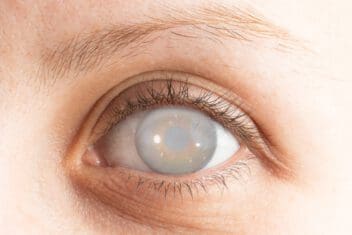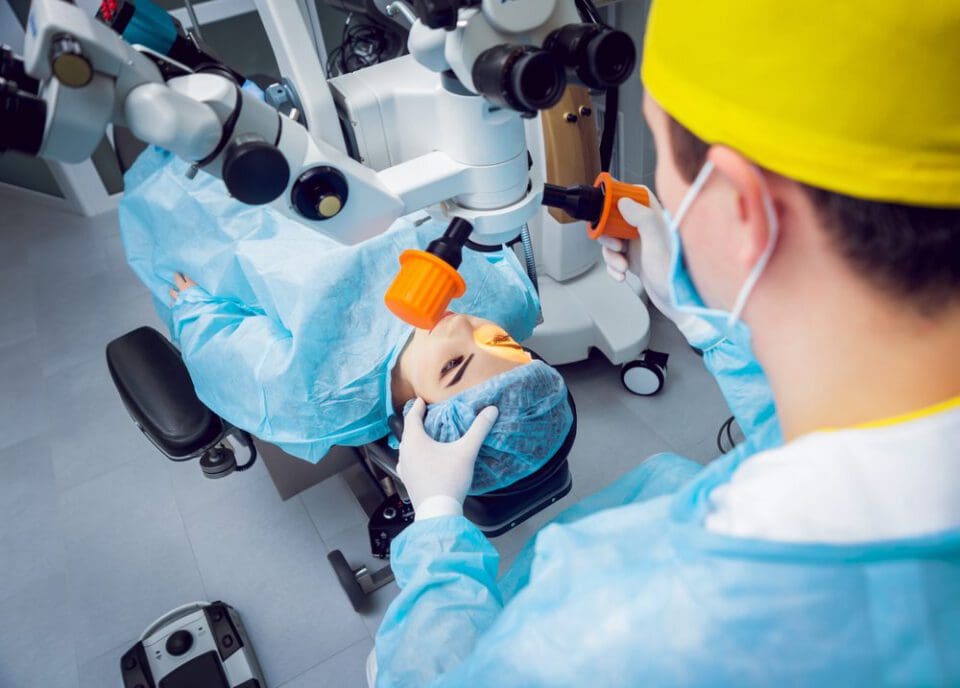
Medically Reviewed by Angelique J. Pillar, M.D. NVISION Surgeon
Laser Cataract Surgery: 5 Things to Know First
Home / Guide to Cataract Surgery /
Last Updated:

Medically Reviewed by Angelique J. Pillar, M.D. NVISION Surgeon
Table of Contents
Laser cataract surgery makes use of precise laser technology in order to perform critical steps of cataract surgery. Cataract surgery involves removing the cloudy lens of the eye and replacing it with an artificial lens. This allows for clear vision.

In traditional manual surgery, the incisions and fragmentation of the lens is done by hand. In laser cataract surgery, the laser makes the incision, creates a perfect circular opening in the lens, and softens the lens for removal in the operating room. The recovery of both surgeries is roughly the same. Laser cataract surgery is more expensive than traditional manual cataract surgery.
Surgery for Cataracts: Manual vs. Laser
In the past, cataracts were treated with traditional surgery, but the rise of laser eye surgery has led to more options for patients.
Manual Cataract Surgery
Traditional cataract surgery (also referred to as manual surgery or phacoemulsification) is very commonly performed in the United States, and it is very safe and effective.
You deserve clear vision. We can help.
With 135+ locations and over 2.5 million procedures performed, our board-certified eye surgeons deliver results you can trust.
Your journey to better vision starts here.
In traditional surgery, the eye surgeon uses a scalpel blade to make a small, manual incision in the side of the cornea. A microsurgical instrument is inserted through the incision, where it reaches the lens, sitting behind the pupil. The surgeon uses the instrument to cut a circular opening in the lens, where a probe is inserted to apply ultrasound waves to break up the protein clumps that form the cataracts.
The broken pieces are removed via suction, and an artificial intraocular lens is used to replace the part of the natural lens that was removed. The side walls of the incision made into the cornea will be filled with a liquid that automatically seals after the surgery, rendering stitches unnecessary.
Laser Cataract Surgery
With laser eye surgery for cataracts, a camera or an ultrasound imaging device is placed over the patient’s eye to create a digital map of its surface and the cataract. This device transmits the information to a computer, which gives the laser the precise location, size, and depths of the incision to make. The computer is programmed by the surgeon to correct astigmatism, to create a precise opening in the lens capsule and to soften the lens.
Afterward, the surgeon then uses an ultrasound probe (the kind used in traditional surgery)to vacuum out the already softened cataract pieces so they can be gently removed out of the eye. As with manual surgery, the doctor will place an artificial intraocular lens into the eye and seal the incision so no stitches are needed.
Laser Eye Surgery for Cataracts: 5 Things To Know

Here are five things you should know first before making a decision:
- Laser surgery for cataracts is not covered by most insurance plans. The long history of manual surgery makes it a preferred option for insurance companies, and only a few programs have evolved to include laser surgery as part of their plans. Health insurance providers may only offer to cover part of a laser eye operation and only if certain criteria are met. Generally speaking, the development of cataracts as the result of the natural aging process would not fit this criteria.
- Laser treatment might be more effective. Lasers could be better at breaking up the protein clumps on the surface of the cornea, which would make laser eye surgery for cataracts a safer alternative than traditional treatment. A spokesperson for the American Academy of Ophthalmology said that “softening” the cataract creates a reduced chance of damage to the eye. In addition, lasers are more precise at correcting astigmatism, the imperfection in the curvature of the eye.
- Not everyone qualifies for laser eye surgery. If you have pre-existing mental health or medical conditions that affect the health of your eyes, or if you take certain medications, you might not be a good candidate for laser treatment. This means that an eye surgeon will not recommend you get laser surgery, your recovery from laser treatment will be longer and more inconvenient, or you might have persisting side effects and other problems with your vision after the treatment. Such restrictions do not exist for manual cataract surgery unless you have very specific medical considerations that make any surgery a prohibitive risk.
- They have similar recovery times. There is not a significant difference in how long it takes to recover from laser eye surgery for cataracts compared to traditional surgery. Vision will be sensitive for the first day or so after either surgery, and you should avoid using your eyes in low-light conditions, driving in poor visibility, or focusing your vision on precise tasks like reading small print. Within three days, your eyes should be free of cataracts, and blurriness should have subsided. As long as you take care of your eyes, there should be no further complications four weeks after the surgery. This timeline is roughly the same for either form of treatment.
- Results are similar. Laser treatment allows a surgeon to make infinitesimally more precise incisions in your cornea (and in less time), but research has not shown that laser-assisted cataract surgery offers fewer complications or even better visual results than manual cataract surgery. The Ophthalmology and Therapy journal noted that “both methods are extremely successful and safe.” In either form of treatment, the ultimate outcome greatly depends on the experience and the finesse of the surgeon performing the operation.
Risks of Laser Cataract Surgery
As with any laser eye surgery, there are certain risks involved with laser eye surgery for cataracts, such as the following:
- Swelling
- Infection
- Bleeding
- Injury to the eye

How to Choose the Cataract Surgery That Is Right for You
The choice between manual or laser cataract surgery will ultimately come down to what a patient wants from their surgery. Some people simply want to replace a cloudy lens with a clear implant, and they are perfectly content to wear glasses to complement their improved vision. Others want the best possible vision they can get without glasses, and they are willing to pay more money to get that.
Researchers writing in the Ophthalmology and Therapy journal suggest that the two forms of treatment do not have to be in contention with one another. Laser cataract surgery was developed in the mid 1990s and has been around now for over 25 years. Laser-assisted surgery is a good complement to the long history and widespread acceptance of manual cataract surgery.
As you weigh your options regarding getting laser eye surgery for cataracts, talk with your doctor about your vision needs, your resources, and your expectations for life after cataracts. This conversation will help you choose the surgical option that is right for you.
You deserve clear vision. We can help.
With 135+ locations and over 2.5 million procedures performed, our board-certified eye surgeons deliver results you can trust.
Your journey to better vision starts here.
References
- Facts About Cataracts. (September 2015). National Eye Institute.
- Does Everyone Get Cataracts Eventually? (June 2012). Live Science.
- Traditional Cataract Surgery vs. Laser-Assisted Cataract Surgery. (August 2017). American Academy of Ophthalmology.
- The Benefits and Drawbacks of Femtosecond Laser-Assisted Cataract Surgery. (June 2020). European Journal of Ophthalmology.
- LASIK Eye Surgery. (December 2017). Mayo Clinic.
- Cataract Surgery. (March 2018). Mayo Clinic.
- A Review of Laser-Assisted Versus Traditional Phacoemulsification Cataract Surgery. (June 2017). Ophthalmology and Therapy.
- The Latest Evidence with Regards to Femtosecond Laser-Assisted Cataract Surgery and Its Use Post 2020. (March 2021). Clinical Ophthalmology.
- Femtosecond Laser-Assisted Cataract Surgery Versus Phacoemulsification Cataract Surgery (FACT). (March 2020). Ophthalmology.

Angelique J. Pillar, MD is a fellowship trained and board certified ophthalmologist specializing in cataract, cornea, and refractive surgery.
This content is for informational purposes only. It may have been reviewed by a licensed physician, but is not intended to serve as a substitute for professional medical advice. Always consult your healthcare provider with any health concerns. For more, read our Privacy Policy and Editorial Policy.
